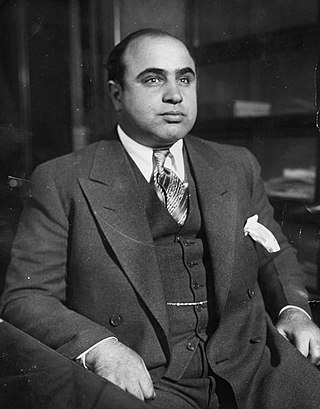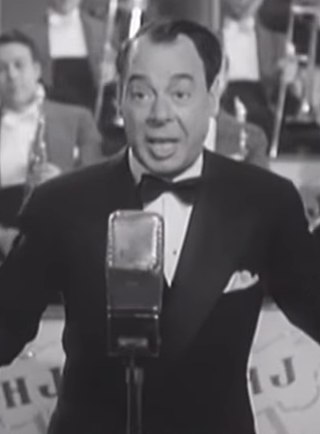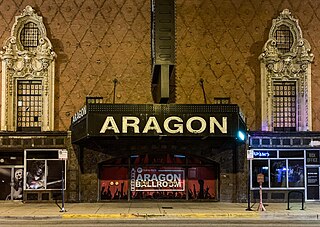
Alphonse Gabriel Capone, sometimes known by the nickname "Scarface", was an American gangster and businessman who attained notoriety during the Prohibition era as the co-founder and boss of the Chicago Outfit from 1925 to 1931. His seven-year reign as a crime boss ended when he went to prison at the age of 33.

The Saint Valentine's Day Massacre was the murder of seven members and associates of Chicago's North Side Gang on Saint Valentine's Day 1929. The men were gathered at a Lincoln Park, Chicago garage on the morning of February 14, 1929. They were lined up against a wall and shot by four unknown assailants, two of whom were disguised as police officers.

Mary Louise Cecilia "Texas" Guinan was an American actress, producer, and entrepreneur. Born in Texas to Irish immigrant parents, Guinan decided at an early age to become an entertainer. After becoming a star on the New York stage, the repercussions of her involvement in a weight loss scam motivated her to switch careers to the film business. Spending several years in California appearing in numerous productions, she eventually formed her own company.

Eliot Ness was an American Prohibition agent known for his efforts to bring down Al Capone while enforcing Prohibition in Chicago. He was leader of a team of law enforcement agents nicknamed The Untouchables, handpicked for their incorruptibility. The release of his memoir The Untouchables, months after his death, launched several screen portrayals establishing a posthumous fame for Ness as an incorruptible crime fighter.

A speakeasy, also called a blind pig or blind tiger, was an illicit establishment that sold alcoholic beverages. The term may also refer to a retro style bar that replicates aspects of historical speakeasies.

Jack "Machine Gun Jack" McGurn was a Sicilian-American boxer, mobster, and eventually a made man and caporegime in Al Capone's Chicago Outfit.

Uptown is one of Chicago's 77 community areas. Uptown's boundaries are Foster Avenue to the north; Lake Michigan to the east; Montrose Avenue, and Irving Park Road to the south; Ravenswood Avenue, and Clark Street to the west. To the north is Edgewater, to the west is Lincoln Square, and to the south is Lakeview. Near the lake are some of the northern reaches of Lincoln Park, including Montrose Beach and multiple nature reserves. The area has a mix of commercial and residential development, and includes a well-established entertainment district of clubs and concert venues, and was a center for early film making. Truman College, a two-year city college, is located here, and the area's southwest corner includes the historic 19th century Graceland Cemetery.

Marc Kelly Smith is an American poet and founder of the poetry slam movement, for which he received the nickname Slam Papi.
The Velvet Lounge was a nightclub in the South Loop of Chicago. It started as a jazz club and was called the "dusty epicenter of the Midwest's free form jazz scene." It was located at 2128 1/2 S. Indiana Avenue before moving to 67 E. Cermak when the original building was scheduled for demolition. It closed permanently in 2019.

Joe E. Lewis was an American comedian, actor and singer.
The North Side Gang, also known as the North Side Mob, was an Irish-American criminal organization within Chicago during the Prohibition era from the early 1920s to the mid-1930s. It was the principal rival of the South Side Gang, also known as the Chicago Outfit, the crime syndicate of Italian-Americans Johnny Torrio and Al Capone.

Double Door, a concert hall and nightclub, was located in the Wicker Park neighborhood of Chicago, Illinois, United States. The venue was first opened on June 12, 1994, and was co-owned by Andrew Barrett, Sean Mulroney and Joe Shanahan. On June 12, 1994, under its current ownership, the Double Door hosted its first show, Lloyd Cole; the same week, the Smashing Pumpkins played under the name the Starchildren. The venue at 1572 N. Milwaukee Avenue had a capacity of 473 people. It was two levels with a stage, sound system, dance floor and bar on the main floor; the second was a mezzanine level, the most intimate area of the club with its lounge type setting. A second bar and dance floor, Door No. 3, was located downstairs in the basement.
Ralph James Capone was an Italian-American mobster and an older brother of Al Capone and Frank Capone. He got the nickname "Bottles" not from involvement in the Capone bootlegging empire, but from his running the legitimate non-alcoholic beverage and bottling operations in Chicago. Further family lore suggests that the nickname was specifically tied to his lobbying the Illinois Legislature to put into law that milk bottling companies had to stamp the date that the milk was bottled on the bottle. He was most famous for being named by the Chicago Crime Commission "Public Enemy Number Three" when his brother Al was "Public Enemy Number One".
Claude "Screwy" Maddox, born John Edward Moore, was a Chicago mobster and head of the Circus Cafe Gang whose ranks included future Chicago mobsters Anthony "Tough Tony" Capezio, Vincenzo De Mora and Antonino "Tony" "Joe Batters" Accardo.

The Byline BankAragon Ballroom is a ballroom turned event space located in Chicago in the Uptown neighborhood, approximately 5 miles (8 km) north of Downtown.

The Uptown Broadway Building is a historic three-story building at 4703–4715 North Broadway in Uptown, Chicago. Built in 1926, it was designed by Walter W. Ahlschlager and is known for its ornate terra-cotta facade, depicting ancient gods, rams' heads, shields, helmets, birds, fruits, and trophies. Lynn Becker of the Chicago Reader has called the exterior "a riotous, Spanish-baroque-inspired hallucination". According to unconfirmed local legends, Al Capone operated a speakeasy in the building's basement.
The Kiss Kiss Cabaret is a live weekly variety show presenting vaudeville and neo-burlesque on Friday nights at the Uptown Broadway Building in Chicago, IL.
Whitney Chitwood is a stand-up comedian from Chicago. Her debut album, 2019's The Bakery Case, was produced by Grammy winner Dan Schlissel for Stand Up! Records. It reached No. 9 on the Billboard Comedy Albums chart, and No. 1 on the iTunes and Amazon comedy charts.
Marvin Tate is an American artist, poet, and singer-songwriter from Chicago.















